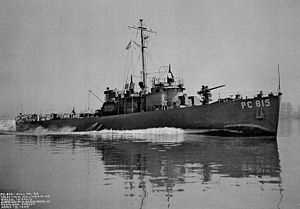Submarine chaser

A submarine chaser is a small and fast naval vessel, specifically intended for anti-submarine warfare. Although similar vessels were designed and used by many nations, this designation was most famously used by ships built by the US. Many of the US World War I sub-chasers found their way to friendly powers by way of Lend-Lease in World War II.
Submarine chaser variants
U.S. Navy submarine chasers were designed specifically to destroy German submarines in World War I, and Japanese and German submarines in World War II. The small 110-foot (34 m) SC-1-class submarine chasers of the design used in World War I carried the hull designator SC (for Submarine Chaser).[1] Their main weapon was the depth charge. They also carried machine guns and anti-aircraft guns. The similar-sized SC-497-class was built for World War II. Also in World War II, larger 173-foot (53 m) PC-461-class submarine chasers used the PC hull classification symbol (for Patrol, Coastal).[2]
In early 1915, the British Admiralty selected the US Elco company for the production of 50 Motor Launches for anti-submarine work, British industry being at maximum capacity. This order was eventually increased by a further 530. The whole order was completed by November 1916, and the vessels entered Royal Navy service. The vessels were 80 feet (24 m) in length and capable of 20 knots (37 km/h). They were armed with a 3-pounder gun, towed paravanes to attack submarines and, later, depth charges.[3] Additional motor launches of the Fairmile A and B and other classes were built for World War II.[4]
War service
The British sub chasers were operated around the coast in defence. However, they were uncomfortable, wet and not suited to British sea conditions. Although used during the First World War, they were sold off when the war ended.
Submarine chasers were used mostly by the United States Coast Guard in World War II for destroying German U-boats that were stationed off the coast of the United States that were trying to sink merchant convoys as they departed American ports. By the end of World War II, submarine chasers had sunk around 67 German U-boats. In the Pacific Theatre, submarine chasers were used for amphibious landings, courier and escort duty.[5][6][7]
Eight British Fairmile B Motor Launches were transferred from Canada to the US in World War II, and included the SC-1466 class of sub-chasers.[8][9]
The Imperial Japanese Navy had around 250 submarine chasers in World War II, principally about 200 of the No.1-class auxiliary submarine chasers. Some of these survived to serve in the Japan Maritime Self Defense Force (JMSDF) after the war.[10]
During Project Hula, the United States secretly transferred 32 U.S. Navy submarine chasers to the Soviet Union between 26 May and 2 September 1945, and some of these saw action in the Soviet Navy during Soviet military operations against the Japanese between 9 August and 2 September 1945. The transfer of 24 more was canceled when transfers halted on 5 September 1945, three days after the Japanese surrender. Between 1954 and 1960 all 32 transferred submarine chasers were scrapped by the Soviet Union or destroyed off its coast by mutual agreement between the two countries.[11]
Post-war
They were mostly withdrawn after World War II and replaced with corvettes, frigates, and destroyers. A few are still in service with Third World navies.
Survivors
The only remaining submarine chaser with intact World War II armament is the Royal Norwegian Navy's HNoMS Hitra, which is a touring museum today. In the Netherlands, there is still afloat PC1610 - a post World War II submarine chaser. The Le Fougueux was built in 1953 from US World War II drawings.[12]
See also
References
- ↑ Gardiner, pp. 132-133
- ↑ Gardiner and Chesneau, pp. 71, 152-154
- ↑ Gardiner, p. 101
- ↑ Gardiner and Chesneau, p. 71
- ↑ Submarine Chaser Photo Archive NavSource
- ↑ Splinter Fleet - The Wooden Subchasers of World War II
- ↑ Gardiner and Chesneau, pp. 71, 152-154
- ↑ "Sunday Ship History: Submarine Chasers" EagleSpeak
- ↑ Gardiner and Chesneau, p. 71
- ↑ Watts, pp. 279-288
- ↑ Russell, Richard A., Project Hula: Secret Soviet-American Cooperation in the War Against Japan, Washington, D.C.: Naval Historical Center, 1997, ISBN 0-945274-35-1, pp. 35, 37-38, 40.
- ↑ P641 Le Fougueux
- Gardiner, Robert, Conway's all the world's fighting ships 1906–1921 Conway Maritime Press, 1985. ISBN 0-85177-245-5.
- Gardiner, Robert and Chesneau, Roger, Conway's all the world's fighting ships 1922-1946, Conway Maritime Press, 1980. ISBN 0-83170-303-2.
- Watts, Anthony J., "Japanese Warships of World War II", Doubleday, 1966. ISBN 0-385-09189-3.
External links
- Subchaser Archives a site dedicated to US World War I subchasers.
- Subchasers at Ships of the U.S. Navy, 1940–1945
| ||||||||||||||||||||||||||||||||||||||||||||||||||
| ||||||||||||||||||||||||||||||||||||||||||||||||||||||